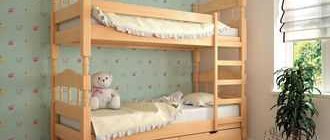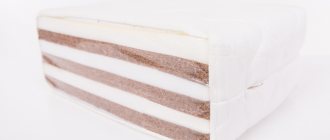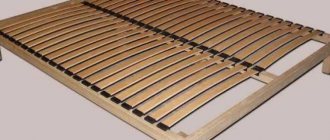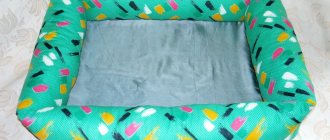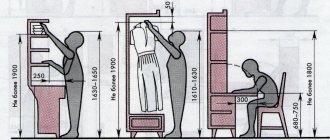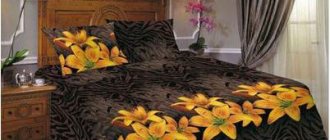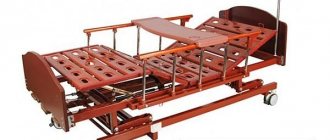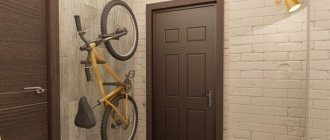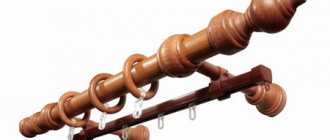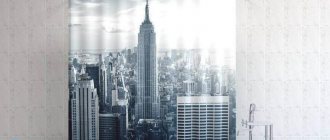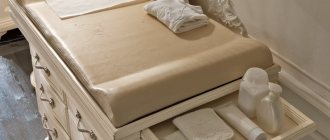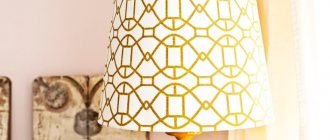What is a mattress pad for?
A mattress cover is not just a decorative element. It performs a number of useful functions:
- Protects the mattress from contamination and exposure to adverse environmental factors - high humidity and dampness;
- Helps keep you warm in winter or cool in summer;
- Protects the mattress from wear on the outer surface, extending its service life;
- Provides additional softness and comfort while sleeping;
- Performs a transformation function if necessary, this is relevant for those who want to combine two mattresses into one large one;
- Saving money - it is better to buy a new mattress topper than an expensive mattress.
Each of these features is aimed at extending the life of the main mattress. Also, the use of this accessory serves to prevent the development of various diseases.
What is a topper for?
Folding sofas are used day and night, experience double load and wear out quickly. However, most of them do not have a full orthopedic basis. A thin mattress, 2 to 8 cm high, will correct the following shortcomings:
- Levels the surface of the sofa;
- will combine its sliding parts;
- will make the sleeping place more comfortable;
- adjusts the softness and hardness of the sleeping place;
- will give the sofa orthopedic properties;
- will extend its service life.
Main types of mattress covers
The division of products into types is quite arbitrary. Traditionally, mattress covers are usually divided into thin and thick. The first type includes:
- Protective. Their main function is to protect the mattress from dust and dry contaminants, to extend their service life by protecting the top layer from wear;
- Moisture-proof or waterproof. They protect the mattress from moisture due to the presence of a special layer - a membrane that repels moisture and at the same time allows air to pass through;
- Antibacterial or hypoallergenic. Made from materials that do not cause allergies, they protect the bed from the penetration of dust mites and fungi thanks to a special impregnation with a bactericidal solution;
- Medical. Aimed at protecting the sleeping area from the penetration of various liquids, they are used mainly for caring for bedridden patients.
Thick mattress covers include:
- Orthopedic. Perform the function of regulating rigidity.
- Woolen. They have a healing effect for circulatory dysfunction, radiculitis, osteochondrosis and muscle pain of various origins. Such mattress covers soften the excessive hardness of the main mattress.
- Demi-season. Aimed at thermoregulation. Usually they have two sides - winter and summer.
Helpful advice: When choosing a mattress topper, you need to take into account your primary needs, parameters and type of mattress. A properly selected product will help solve health problems and increase the level of comfort in your sleeping area.
Fillers for mattress covers
The filling material plays a very important role when choosing a mattress topper. Natural or synthetic raw materials of the middle layer determine the basic properties and functions of the product.
Synthetics are a more durable and thin material, have hypoallergenic properties, are durable and versatile. The main synthetic fillers include:
- Polyurethane foam or artificial latex . Used to increase the softness of the mattress, it is affordable, wear-resistant, comfortable and elastic.
- Sintepon or holofiber . Practical, soft and comfortable material, easy to wash and does not lose its shape and attractive appearance over a long period of time.
- Memory . A special type of polyurethane foam with shape memory effect. This is one of the softest fillers, which under the influence of heat and load reduces elasticity. This material is very expensive and not everyone can afford it. Such mattress covers are indicated for elderly people, bedridden patients and people suffering from circulatory problems.
- Struttofiber . The filler fibers have a vertical orientation and a dense structure. Ideally regulates the level of mattress hardness, can smooth out depressed areas and increase the comfort of the sleeping place.
Natural materials are certainly more environmentally friendly and safe. However, they are contraindicated for people suffering from allergic reactions. The main fillers of this type are:
- Latex . In the absence of an allergy to this material, such a mattress cover can improve the anatomical characteristics of the mattress and sleep comfort. Latex is produced from the milk of the tropical Hevea tree by foaming and further drying.
- Bamboo . The raw materials have antibacterial properties, maintain the hygiene of the sleeping area, and protect against the appearance of parasites and dust mites.
- Coconut fiber . Designed to increase the rigidity of the mattress, allows air and moisture to pass through well, and helps cool the body during hot weather.
- Wool . It has a warming effect in winter cold and has a wide range of medicinal properties. Manufacturers often offer double-sided mattress covers, one side of which is wool, and the other is made of cotton or silk.
- Pooh . A mattress pad filler known for its warming properties. This option is indicated for people who want to increase the softness of the mattress.
Helpful tip: Remember, if you suffer from allergies, it is better to choose a mattress cover made of synthetic material.
Which fillers do you prefer?
The choice of filling for a mattress is determined by the required characteristics of hardness, moisture resistance, degree of ventilation, as well as susceptibility to allergies and a number of other parameters. What “fillings” are found in modern models of sofa mattresses?
Latex (natural or synthetic)
An environmentally friendly filler that is well ventilated and maintains a comfortable microclimate. By definition, a latex mattress cannot harbor bedbugs and other insects. It does not cause allergies, has an antibacterial effect and perfectly softens hard surfaces. The service life of a latex topper is on average 20 years.
Latexed coconut coir
Another type of popular filler, which, on the contrary, increases surface hardness. Natural coconut fibers are impregnated with a special latex composition, which increases the service life of the product. Coconut mattresses are ready to withstand loads of up to 120 kg. True, they are not very suitable for older people, but they are ideal for children and teenagers .
Strutofiber
Provides the mattress with medium firmness. The filler contains polyester fibers bonded as a result of heat treatment. Such models are “airy” and retain heat well.
Memory
Material with a “memory” effect that follows the contours of the body and helps the muscles relax perfectly.
Polyurethane foam
Budget synthetic filler that does not absorb moisture and does not cause allergies. The service life of products with such a “filling” is less than, say, with latex.
The basis of a thin mattress can be one type of filler or various combinations.
Product hardness levels
The hardness of mattress covers varies depending on the following division:
- Soft, used to increase the softness of the mattress. They are most often made from natural or artificial latex.
- Medium-hard, aimed at adjusting the rigidity of an orthopedic mattress and changing the height of the sleeping place. The material for the manufacture of these products is holofiber or polyurethane foam.
- Hard, used to increase rigidity. The material for them is coconut coir.
- Combined, made from several layers of different materials and having a wider range of properties. These mattress covers are considered the best.
Based on these parameters, each buyer will be able to choose a mattress cover for an orthopedic mattress that matches their taste preferences and the required hardness.
Types of fillers for toppers
Fillers for toppers are made from natural, artificial and combined hypoallergenic materials with orthopedic properties. Let's look at the most popular of them.
Coconut coir is a plant fiber obtained from the intermediate layer of the wall of the coconut fruit. Depending on the manufacturing technology, it can be latexed or pressed. Latexed coir is a durable, wear-resistant, elastic and load-resistant filler. The ratio of natural latex and coir in its composition is 50/50 or 30/70. The less latex, the firmer the mattress. The disadvantages of this filler include its high cost. Pressed coir consists of 100% coconut fiber. During its production, the fibers are first pressed and then punched with special needles, fastening them together. It is cheaper than latex, more rigid and delaminates over time.
Latex is natural foam rubber. This is an elastic, resilient, durable, fairly soft material that can withstand a lot of weight. Only Memoryform foam can compete with its orthopedic properties. Manufacturers give latex a porous structure that provides it with good thermoregulation. The main disadvantage of latex is its high cost.
Artificial latex is a highly elastic foamed polymer material that is as elastic, resilient and breathable as natural latex. But it is more rigid and less durable. Accordingly, it costs less. This is a good option if you don't want to spend a lot of money on natural latex. This topper will be enough for several years.
Polyurethane foam - foamed polyurethane. The properties of this material and artificial latex are similar, but it is not as elastic and a little softer. Polyurethane foam sags and wears out faster. The popularity of this filler is explained by its budget price. This is a good option if you want to make your sofa softer for sleeping as inexpensively as possible.
Memory foam (memoriform) is a viscoelastic polyurethane of medium hardness with a high orthopedic effect. It exactly follows the contours of the human body, providing excellent support to the spine. Memoryform does not have a pushing effect, so sleeping on a mattress made from it is very comfortable. Disadvantages: high price and poor air permeability, due to which the mattress quickly heats up.
Combined fillers. Recently, many combined orthopedic materials have appeared that combine the advantages of natural and artificial fillers and reduce their disadvantages. They are characterized by hypoallergenicity, durability, good thermoregulation, and their hardness depends on the hardness of the components. Included in their composition. These are materials such as Ergolatex (a mixture of polyurethane and latex in a ratio of 70/30), Strutofiber (20% wool, cotton, seaweed or coconut coir and 80% polyester fibers) and others.
Types of mattress attachments
To securely fix the mattress cover on the surface of the mattress, special fastenings are required. The type of fastening is chosen depending on the thickness of the mattress. There are three types of product fastening:
- With elastic bands at the corners . The most popular method that prevents the accessory from slipping off. Basically, mattress covers with elastic bands are used for mattresses with a height of no more than 30 cm. The disadvantage of such fastening is that over time the elastic bands stretch, and there is a need to replace them.
- Mattress cover with Velcro . As a rule, this method of fastening is inherent in products that are large in thickness and made of dense fabric.
- Case . This mattress pad looks natural, like part of the mattress. The design of the product allows you to close it completely both at the ends and on the sides. The cover can be with an elastic band or with a zipper. A zipper allows you to close the mattress on all sides.
The choice of fastening type depends solely on the wishes of the owner. It is worth noting that the option with elastic bands is an inexpensive option available to almost everyone.
The most important thing is that the size of the mattress cover matches the parameters and height of the mattress.
Which companies produce mattresses for sofas?
Mattress covers can be found in the product line of all manufacturers producing products for healthy sleep. Thus, Ascona, well known for its large-scale advertising on the Internet, offers a knitted mattress cover “Nika” 2 cm high with polyester fiber, as well as a topper “Nefela” 5.5 cm high with perforated latex filling.
Among the models from the Ormatek factory you can see a new product - the Sakura mattress cover, which consists of two centimeter layers of sisal and thermal felt. One of the bestsellers is the “Simple Plus” topper made of cotton and a special fiber that does not cause allergies.
The assortment includes the original Aloe Vera mattress cover, which is recommended for the most sensitive skin , as well as the Bamboo topper with the addition of bamboo fibers.
There is also a good selection in the catalogs of the Consul factory, where toppers with coconut and latex filling, as well as with elastic memory foam, are presented.
Some types of toppers can be used not only at home, but also when going on a business trip or travel. In this case, you will be able to sleep well in an unfamiliar place on your own mattress, and on the road you can use a travel pillow. And this, you see, is extremely convenient.
A mattress protector is a cover that serves as an additional layer to the mattress. It is much thinner than the mattress itself and is easy to install and remove. Modern manufacturers offer a wide range of options that can satisfy even the most demanding customers. Do not forget about the main functions of this accessory.
Fabrics for covers
Manufacturers produce single-layer and multi-layer mattress covers. The product, consisting of only one layer, is used exclusively as a protective cover, protecting the surface from dust, moisture and premature wear.
Waterproof mattress covers are made with two layers. The upper part is mainly made of cotton, while the lower part is made of water-resistant fabric.
Most mattress covers consist of three layers. The middle layer is made from natural and synthetic fillers, which were mentioned above. The lower and upper parts are usually a surface that is pleasant and dense to the touch. The fabrics of these layers are necessarily breathable to improve ventilation qualities.
The most widely used types of materials are:
- jacquard,
- silk,
- cotton,
- satin,
- bamboo fiber,
- polycotton.
All these fabrics have a high degree of wear resistance and do not require complex care. Sometimes the mattress cover material is treated with special antibacterial mixtures. This action is aimed at improving hygienic properties.
The most attractive and aesthetic variety is the quilted mattress cover. In addition, the stitch promotes uniform distribution of the filler and greatly simplifies the care of the product.
How to choose a mattress pad for your bed?
When choosing a mattress pad for your bed, you need to accurately measure the parameters of the mattress. Typically, mattress covers are sold in standard sizes that correspond to the parameters of the main types of beds for adults and children.
Accuracy in measurements is especially important if you are the proud owner of an orthopedic mattress. It is necessary to carefully measure the length, width and height of the product. A difference of 5 cm will not be significant, since the fabric can stretch to the desired size. This applies to options with fastenings on side elastic bands and mattress covers.
When choosing an orthopedic mattress cover, the height of the main mattress does not matter at all, because the accessory will be attached exclusively to the upper part.
The next criterion that must be taken into account when choosing a mattress cover is your health status, season and taste preferences:
- In summer, it is appropriate to use a thin mattress pad made of cotton or coconut shavings. The product must be of good quality and help cool the body in hot weather.
- In winter, it is better to give preference to a thick product made from wool.
- To save money, it is advisable to purchase universal double-sided winter/summer models.
- If you have health problems, it would be a good idea to choose an orthopedic mattress cover for your bed. Their rigidity is most suitable for the spine. In addition, such modifications are made from materials that are used to make orthopedic mattresses and pillows. That is why they have identical properties and characteristics.
- Allergy sufferers should consider purchasing a hypoallergenic mattress cover or a product with antibacterial impregnation.
Helpful advice: Don't skimp on purchasing a mattress cover. Ask yourself what is cheaper: a mattress pad or a mattress?
Choosing a mattress pad for a sofa
Choosing a mattress cover for a sofa involves solving some important issues. First of all, it is necessary to determine the type of sofa and the features of its sleeping place.
There are two main groups of products depending on the type of design:
- Mattress cover. It is usually made of dense fabric and does not have additional anatomical effects. Its function is only to protect the surface of the sofa from dirt and moisture. This accessory is suitable if the sleeping place consists of a single fabric, which is typical for sofas that fold out like an “accordion” or “sedaflex”.
- Couch or topper. Usually has a small thickness and is easy to fold or roll. This product is ideal for a French folding bed and a sofa, the bed of which consists of separate blocks.
The uneven surface of a worn out and old sofa can be turned into a cozy and comfortable sleeping place if you choose an orthopedic mattress cover of suitable thickness and hardness. If the sofa is characterized by small differences in height or minor recesses, then it is better to choose a thin quilted mattress cover.
Bringing the sofa back to life
Why sweat by the sofa, trying to clean it of dirt? Why relax on a sofa that is no longer as soft and comfortable as it used to be? Cleaning can be simplified several times, and rest can be made more comfortable. This is exactly what mattress toppers are for! By allocating a small amount of money, you can make the sofa soft and reliably protected.
Despite the high quality of production, mattress covers for sofas are quite inexpensive, so everyone has the opportunity to use high-quality products. They are attached to the sofa using special rubber bands, which will allow it to hold tightly and not move out.
Mattress covers for newborns, selection criteria
An important part of a newborn baby's sleeping area is the mattress cover. Before going to the store, you need to decide what the main purpose of the purchase is.
To protect against moisture and dirt, a breathable microfiber cover is ideal, which will reliably protect the surface from various troubles.
If the main goal is to ensure comfortable sleep, then it is recommended to choose an orthopedic mattress cover that provides back support in the first year of life.
It is necessary to pay special attention to the material from which the accessory is made. It must meet safety standards and be hypoallergenic.
Important properties of a children's mattress cover
- The optimal size, ideally matching the parameters of the crib and mattress. A mattress pad that is too small will not be able to cover the entire surface, and a mattress pad that is too large will form wrinkles that interfere with a comfortable and restful sleep.
- Waterproof. This will provide reliable protection against contamination and the spread of pathogenic bacteria.
- Environmental friendliness. Such a product will not harm the baby’s health and will help strengthen the immune system.
- Ability to absorb liquids. Babies' sensitive skin needs careful care and cleanliness; excess moisture can cause diaper rash and irritation.
- Durability. This property will allow you to wash the product frequently without worrying about the safety of its functions.
When buying a mattress cover for a newborn, you should ask the seller about the availability of safety certificates. Knowing these simple criteria, you can easily choose the right product and enjoy a restful sleep and good mood for your baby.
Reviews from young parents who bought mattress covers for a crib confirm the necessity and importance of this purchase.
Rules for choosing a mattress cover
If you need to correct the stiffness of the mattress or replace a full mattress, choose orthopedic products. To choose a good orthopedic mattress pad, pay attention to the hardness. Avoid products that are too soft or too hard.
A mattress pad that is too soft does not provide the necessary support, causing the spine to curve incorrectly and the ligaments and muscles of the body to become overstrained. A product that is too rigid distributes weight unevenly in the shoulders and hips. It causes discomfort during rest and impairs sleep.
